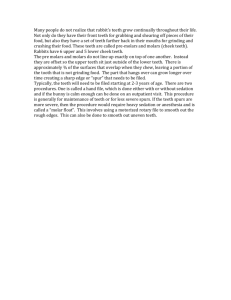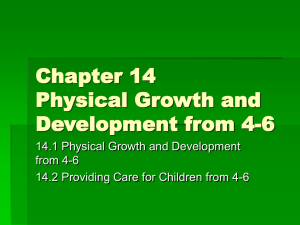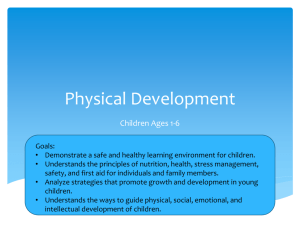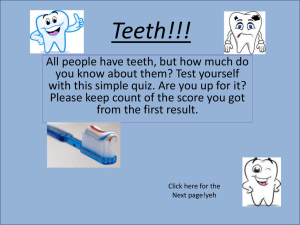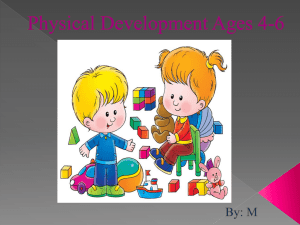Physical Development: 1-3 year olds Ages
advertisement
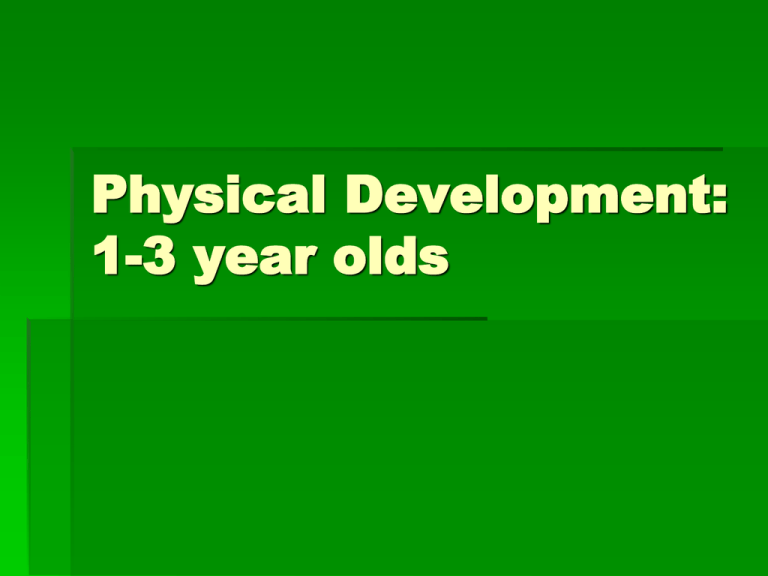
Physical Development: 1-3 year olds Ages Toddler- one to two years old Preschooler- three to five years old or when they start school Factors influencing growth and physical development Genes/heredity Nutrition Health Life experiences Height and Weight Changes From 1-3 years old, height and weight slows by half, as compared to the first year of life. Children also begin to show a greater variation in size Body proportions From 2-3 years old, the chest becomes larger around than the head and the abdomen Arms, legs, and torso lengthen Teeth By age one, child has approximately 8 teeth By age two, 16 teeth By age three, 20 teeth A full set of baby teeth is 20. A child should begin going to the dentist around 18 months to become comfortable and to start preventative care before permanent teeth come in. Developmental milestones Not all children reach these milestones at the same age These are averages Variations are caused by differences in physical size, health, diet, interests, temperament, and play opportunities Can help caregivers choose activities that are developmentally appropriate for child’s age motor skills Gross motor skills 12-18 months: walking 18-24 months: jumps in place 2-2 ½ years: pushes self on wheeled toys 2 ½ - 3 years: alternates feet going up stairs Fine motor skills 12-18 months: picks up small objects with thumb and pointer finger 18-24 months: grasps crayon with fist 2-2 ½ years: turns one page of a book 2 ½ - 3 years: screws lids on and off containers dexterity The skillful use of hands and fingers Turning on a faucet requires greater dexterity than walking steadily Sensory integration Combines information from the various senses to make a single, whole picture of what’s happening Sensory dysfunction is when one cannot process all the information the senses take in; may react more strongly to different types of stimulation, like light or noise, and less strongly to taste or touch. Sleep patterns Age one- two naps, morning and afternoon combining for several hours As children get older, daytime naps become shorter By age two, children typically give up morning nap and sleep longer at night Night terrors vs. nightmares Night terrors occur early in the child’s sleep cycle Night terrors aren’t likely to be remembered Nightmares are frightening dreams that seem real Nightmares are more serious and may signal anxiety in child’s life Self feeding Age 1- eat finger foods, use a spoon, drink from a cup Age 2- use a fork, but eat slowly Age 3- can use spoon and fork skillfully and can chew tough foods cut into small pieces Serving sizes Young children need smaller servings and need to eat more frequently Their stomachs are smaller Food should be offered every 3-4 hours Meal appeal Variety is the key! Provide differences in: Color Texture Shape Temperature Provide an ease of eating- cut up foods Good eating habits Be a role model Try new foods Let child help in kitchen Encourage child to eat only when hungry and eat slowly Don’t use food as reward or punishment Encourage drinking water instead of sugary drinks hygiene Bathing themselves Hand washing Brushing teeth Using the toliet Using a tissue Still need adult supervision and help Toliet teaching Physical and emotional signs of readiness: Can control bladder and bowel functions Recognizes signals that elimination is necessary Can remove clothes easily Shows an interest in wanting to be grown up and use the toliet Can physically control sphincter muscles at 18 months Dressing Starts helping on own at age 13-14 months By age two, can do pants but shirts are difficult By age three, children can dress independently Learns independence, responsibility, self esteem Choosing clothes Comfort Fabric Durability economy fibers of clothes Synthetic Fibers Advantages: Durable Wrinkle resistant Quick drying Disadvantages: Doesn’t absorb moisture well Holds heat and perspiration against body Flame resistant fabric can catch on fire but will not burn as quickly as other fabrics Only sleepwear is required to be flame resistant checkups Ages 12, 15, 18, 24 months and 3 years Vaccines introduce small amount of disease carrying germs to body Vaccines cause immune system to set up defenses against future exposure to that disease Safety hazards and protection Choking Unsafe toys Poisoning Burns Traffic accidents Sunburns pets




